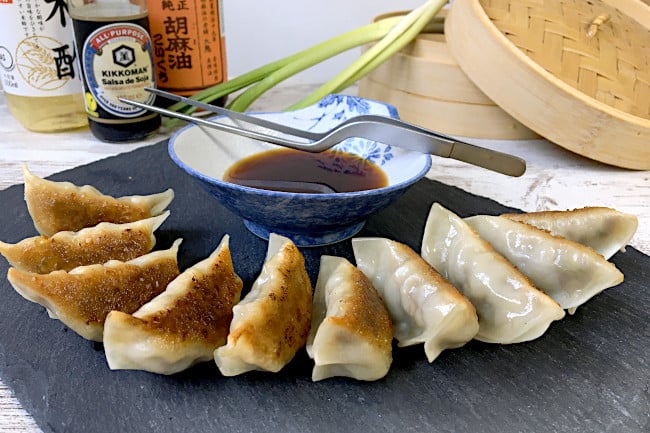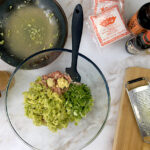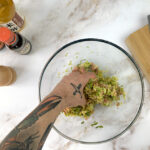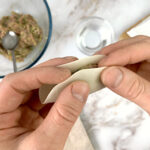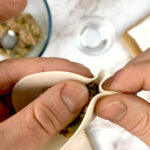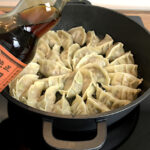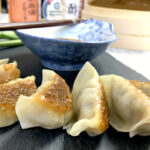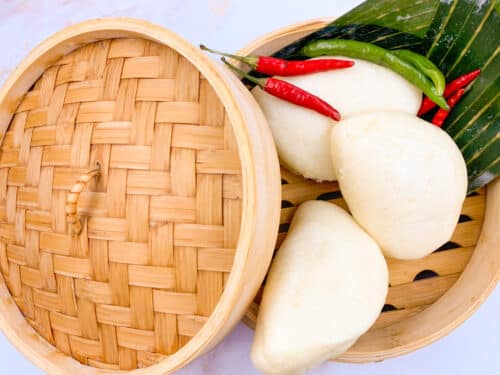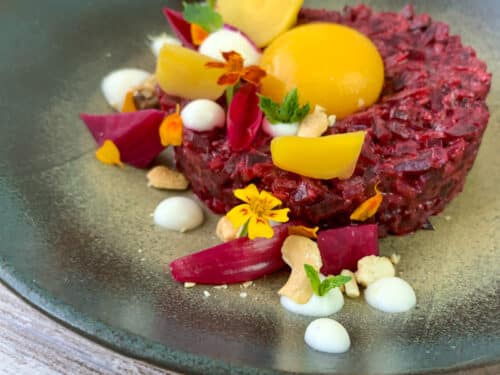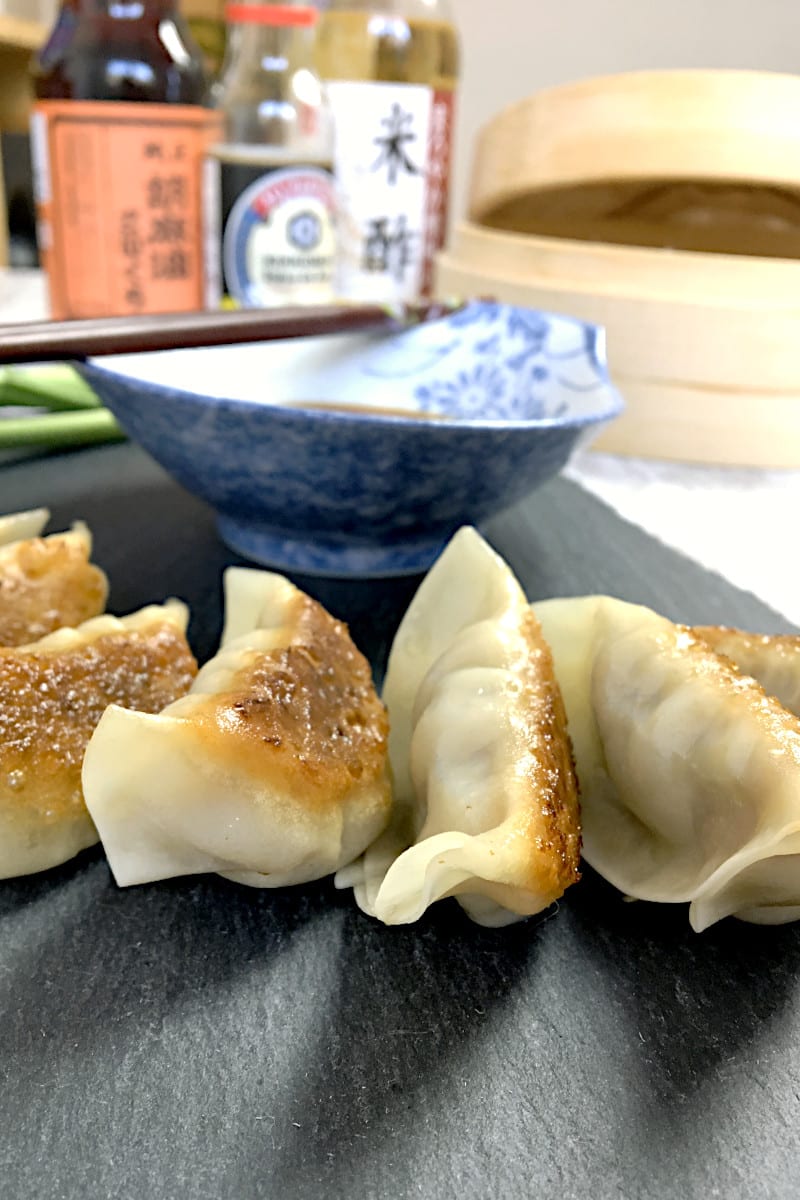
The History of Gyoza
Gyozas are dumplings with a thin wrapper of wheat flour and a finely textured filling made of vegetables, meat or seafood, that can be boiled, steamed, or fried. Dumplings exist in different versions in nearly every part of the world, and it is sometimes hard to tell where they originated and how they influenced each other. Gyozas come from ancient China, and their Chinese name is Jiaozi.
There are several theories about where the name Jiaozi originates but, the most supported theory attributes the invention of Jiaozi to a Chinese medicine practitioner called Zhang Zhongjing from ancient China. He tried to help poor people during the winter, which suffered from frostbite, mainly around their ears, so he cooked meat and a few medicinal herbs, shredded them, and wrapped it in pieces of dough. He shaped them like ears and boiled them, and everyone who was sick received two. The recipe was adapted, and the dumplings soon were consumed across China.
Japanese soldiers became familiar with Jiaozi in World War II during their occupation in China. When they returned home to Japan, they recreated Jiaozi, and so the Gyoza was born.
Today you can find Gyozas in Japanese Restaurants in all different variations around the world.
Where to find Gyoza when in Japan!

Different Gyoza Fillings
Traditionally classic Potstickers are filled with pork meat, but there exists a big variety of fillings, and once you master the technique of folding, you can be creative and make your version.
The classic filling consists of ground pork meat, cabbage, nira (Chines chives), garlic, soy sauce, sake, and sesame oil.
If you do not like pork meat or want to experiment with other fillings, here are some other examples:
- Shrimp (shrimps, garlic, ginger, coriander, soy sauce, rice vinegar, sesame oil)
- Vegetarian (tofu, shitake, cabbage, chives, soybean sprouts, soy sauce, sesame oil)
- Beef (ground beef meat, red onions, garlic, coriander, soy sauce, sesame oil)
- Chicken (ground chicken meat or leftover shredded cooked chicken, cabbage, chives, garlic, ginger, oyster sauce, sesame oil)
- Duck (cooked and shredded duck meat, hoisin sauce, chives, shichimi togarashi)
Try my recipe for steamed bao buns!

Homemade vs. Store-Bougth Wrappers
Nowadays, it is relatively easy to find Gyoza wrappers in Asian grocery stores, but if you can not find any or want to try something new, I will show you how to make your own wrappers from scratch.
If you buy Gyoza wrappers in the store, take care that you do not pick up wonton wrappers, which are firmer, thicker and, often chewier.
If you do not want to use your store-bought wrappers right away, make sure that you keep them in the freezer. Take them out of the freezer the day before and let them defrost in the fridge to use the next day. Once defrosted, you can keep them in the fridge for 3-4 days. If you open the package, try to use everything as fast as possible and always cover them with film again because they dry out quickly and can not be used anymore once they do.
Making Gyoza wrappers yourself is not so difficult and absolutely fun. You only need a handful of ingredients (flour, corn starch, water, and salt), and the process is not as difficult as it seems.
If you want to try making your own wrappers see the recipe here.
How to make your own Gyoza wrappers

The Folding Technique
There are various ways to fold Gyoza wrappers, but I will show you my favorite one, which I consider the easiest. After some practice, you will master the technique quickly and make your Potstickers like a professional.
I will show you step-by-step how to fold your Gyozas in the recipe. While you are folding, keep the remaining wrappers under a damp kitchen towel to keep them from drying out. Once they are closed, put them on a tray lined with parchment paper and cover them with plastic film.
If you are not going to cook them the same day, freeze them on a tray with some space between them. Once they are frozen, you can keep them together in a bag in the freezer.
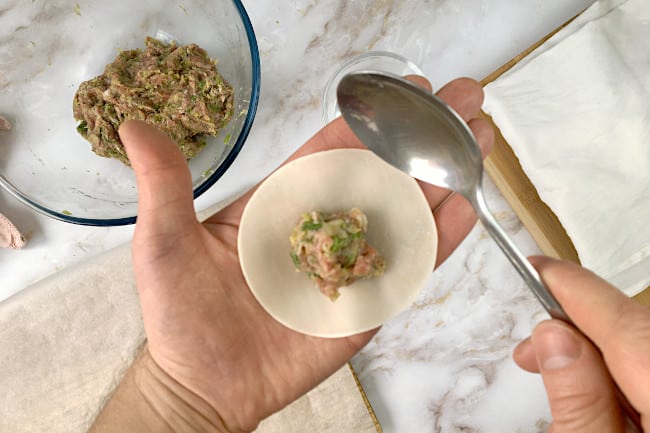
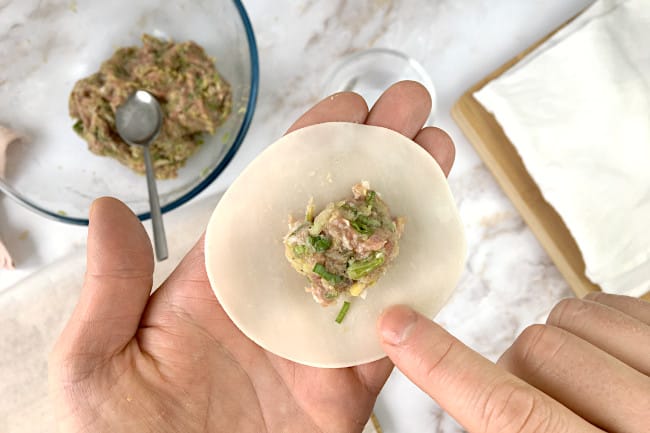
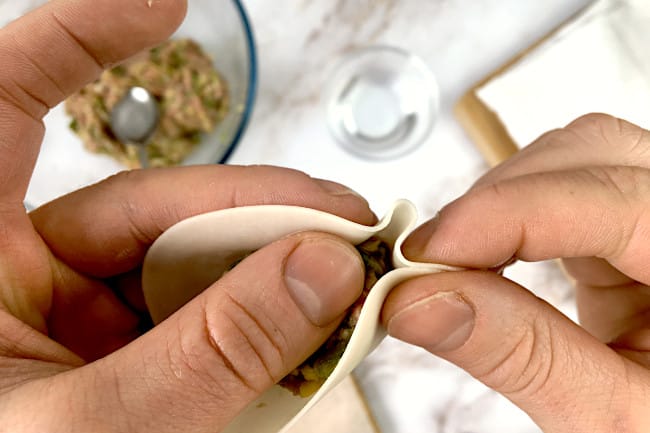
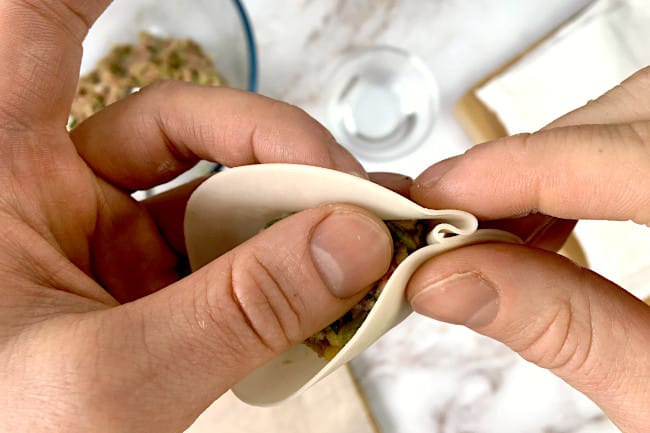
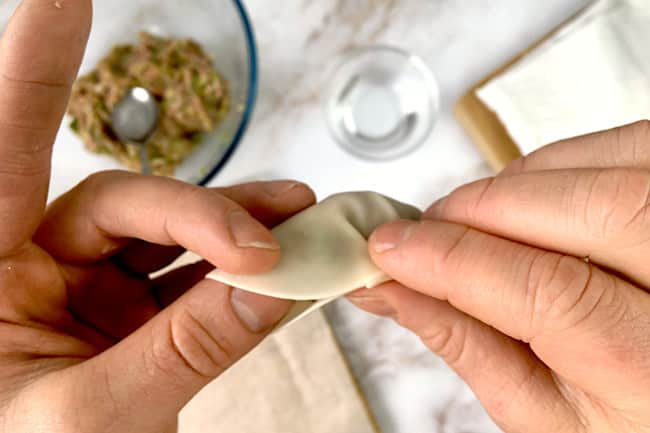

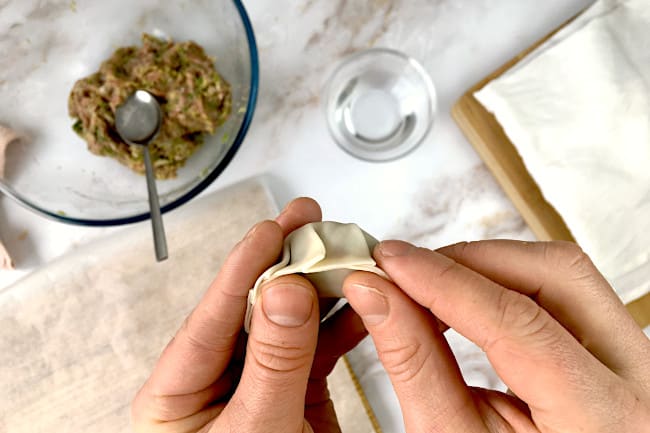
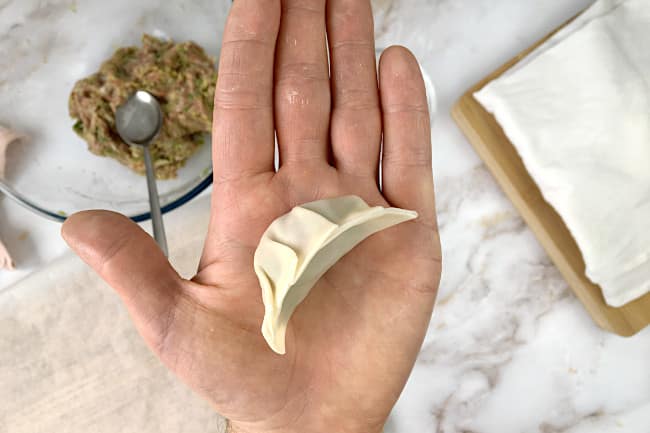
Which Dipping Sauce to serve with Gyoza
The easiest and most traditional way to serve these delicious dumplings is with a dipping sauce made of soy sauce and rice vinegar. If you like it spicy, you also can add some Japanese chili oil (la-yu). When you prefer a less salty version, use light soy sauce.
If you want to try some other dipping sauces, here are some ideas:
- Try adding some grated ginger and garlic.
- Try with ponzu (soy sauce with citrus fruits).
- Try adding shichimi togarashi (7-spice chili powder from Japan).
- Try hoisin or oyster sauce.
- Make a quick dip by blending silken tofu with kimchee sauce.
- Make a mayonnaise with wasabi paste and use some sesame seed oil to mount.

How to cook Gyoza the right way
There exist different ways of cooking these dumplings in Japan, like Sui Gyoza (boiled and mostly served in broth), Age Gyoza (deep-fried), or Mushi Gyoza (steamed). The most common method is called Yaki Gyoza, which involves frying and then steaming in a pan.
They are first fried in a pan until brown on the bottom sides, then a small amount of water is added before the pan is covered with a lid to steam the dumplings until they are cooked. At the end the lid is removed again, to continue frying until they are crispy on the bottom.
Like this, the potstickers stay juicy inside, the top part stays silky and soft, while the bottom part gets golden brown and crispy.

Gyoza Recipe
Equipment
- frying pan with lid
Ingredients
- 2 packages Gyoza wrappers 35-40 sheets
- 1 tablespoon sesame oil for frying
- 1 tablespoon sunflower seed oil for frying
For the filling
- 300 g ground pork meat organic if possible
- 150 g cabbage chopped without the core
- 1 tablespoon ginger grated
- 1 glove garlic grated
- 3 pieces green onions/scallions about 50g, chopped
- 2 tablespoon soy sauce japanese
- 1 tablespoon sesame oil
- 1 tablespoon rice vinegar
- 1 teaspoon salt
- 1/2 teaspoon ground black pepper
- 1 teaspoon corn starch
- 2 tablespoon water
For the sauce
- 3 tablespoon soy sauce japanese
- 3 tablespoon rice vinegar
- 1 teaspoon chilli oil optional
Instructions
The Filling
- Remove the core of the cabbage leaves and cut into fine julienne (small stripes)
- Sprinkle the cut cabbage with 1 teaspoon of fine salt and mix with your hands until the cabbage starts to get soft and let rest for 5 minutes.
- Place the ground pork meat in a bowl. Add 1 teaspoon of corn starch and 2 tablespoons of water and mix well for some minutes until the meat becomes like a paste.
- With your hands squeeze out the water of the salted cabbage and add to the meat.
- Cut the spring onions into small pieces and add to the bowl.
- Add the grated ginger (1 tablespoon), and the grated garlic (1 glove).
- Season with the soy sauce (2 tablespoon), the sesame oil (1 tablespoon) and the rice vinegar (1 tablespoon).
- Add some fresh ground black pepper.
- Knead the mixture with your hands until everything is well mixed, and it becomes sticky.
To Fold the Gyoza
- Always keep the Gyoza wrappers under a damp kitchen towel while you are folding. Prepare a small bowl with water to wet your fingers.
- Take a Gyoza wrapper and place it in the palm of your hand. Use a spoon and put a small amount (approx. 2 teaspoons) of the filling in the center of the wrapper.
- Dip one finger in a bowl of water and draw a circle around the outer part of the wrapper until it’s wet all around.
- Fold the wrapper in half over the filling.
- Using your left thumb and index finger, start making a pleat on the top back part of the wrapper, about once every 1 cm and press against the front part.
- Once you make each pleat, press it down with your right hand using your thumb and index finger.
- Continue with the pleats toward the left side after having pressed together each pleat.
- Continue all the way till there is no more wrapper to pleat.
- Press the pleats and shape the Gyoza (like a half moon).
- Place the closed Gyozas on a tray with parchment paper.
To Cook the Gyoza
- Heat the oil in a large non-stick frying pan over medium heat. When the pan is hot, place the Gyoza flat side down in a circular shape.
- Cook until the bottom of the Gyoza turns golden brown.
- Add 100 ml of water and quickly cover the pan with a lid. Steam the Gyozas for 3 minutes.
- Remove the lid to evaporate any remaining water and add 1 tablespoon of sesame oil.
- Continue to cook uncovered until the Gyozas are golden brown and crisp on the bottom.
The Dipping Sauce
- Mix 3 tablespoons of soy sauce and 3 tablespoons of rice vinegar together. If you like it spicy, add some chili oil or paste.

